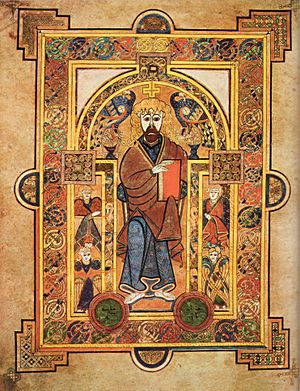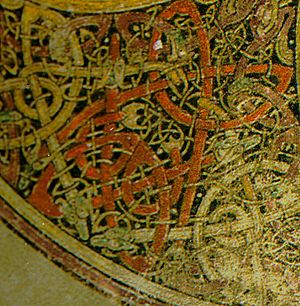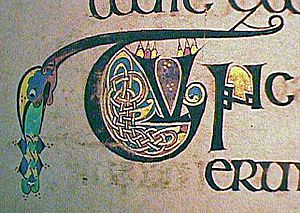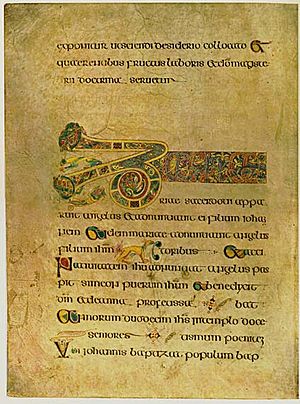Book of Kells facts for kids

The Book of Kells is a very old and beautiful illuminated manuscript. It's written in Latin and contains the four Gospels from the New Testament, along with some other texts.
Celtic monks created this book around 800 AD or a bit earlier. The words of the Gospels mostly come from the Vulgate Bible. Some parts also use older versions of the Bible, like the Vetus Latina. It's considered a masterpiece of Western calligraphy and one of Ireland's most important national treasures.
The pictures and decorations in the Book of Kells are truly amazing. The artwork mixes traditional Christian iconography (religious images) with fancy swirling designs. These designs are common in the art of the British Isles. You'll see figures of people, animals, and mythical creatures. There are also Celtic knots and woven patterns in bright colors that make the pages come alive. Many of these smaller decorations have Christian meanings.
Today, the manuscript has 340 folios, which are separate sheets written on one side. Since 1953, it has been put into four separate books. The pages are made from high-quality calf vellum, which is a type of treated animal skin. There are ten full-page pictures. Many text pages are also bright with decorated initials (big first letters) and tiny pictures between the lines. At least three different scribes (writers) worked on the text. The colors used came from many different materials, some even imported from far-off lands.
The book gets its name from the Abbey of Kells, where it was kept for hundreds of years. Today, you can see it on display at the library of Trinity College, Dublin. The library usually shows two of the four volumes at a time. One volume will show a major illustration, and the other will show a typical page of text.
Copies of the Book of Kells
It's hard for everyone to see the original Book of Kells. So, several copies have been made over the years. These copies help more people study and enjoy this amazing artwork.
Early Copies
In 1951, a Swiss company called Urs Graf Verlag Bern made the first full copy, called a facsimile. Most pages were black-and-white photos. But it also had 48 color pictures, including all the full-page decorations.
Later, in 1974, another company named Thames and Hudson made a second facsimile. This one had all the full-page illustrations in color. It also showed some decorated text pages and zoomed-in details of the artwork.
Modern Copies
By 1986, a Swiss publisher named Faksimile-Verlag found a new way to photograph the pages. They used gentle suction to flatten a page without touching it. This allowed them to take very clear pictures. They got permission to make a new copy. After each page was photographed, a test copy was made. This allowed them to carefully compare the colors to the original and make sure they were perfect. The complete copy was published in 1990. It came in two volumes: the full copy of the book and a book of notes from experts. One copy of this special edition is kept at the Anglican Church in Kells. This church is on the same spot where the original monastery used to be.
In 1994, Bernard Meehan, who looked after the old books at Trinity College Dublin, wrote a small book about the Book of Kells. It had 110 color pictures from the manuscript.
In 2006, Trinity College made a digital copy of the manuscript. This means you can now see the entire book online! You can also see a rare copy of the Book of Kells for free at The Little Museum of Dublin.
Images for kids
-
The Book of Kells, (folio 292r), around 800 AD. This shows the richly decorated text that starts the Gospel of John.
-
This image shows the start of the Gospel of Matthew.
-
Folio 309r shows text from the Gospel of John. It was written in a special old style by the scribe known as Hand B.
-
Folio 7v shows an image of the Virgin and Child. This is the oldest picture of the Virgin Mary found in a Western manuscript.
-
Folio 291v shows a picture of John the Evangelist.
-
Folio 29r shows the beginning of the Gospel of Matthew.
See also
 In Spanish: Libro de Kells para niños
In Spanish: Libro de Kells para niños
















